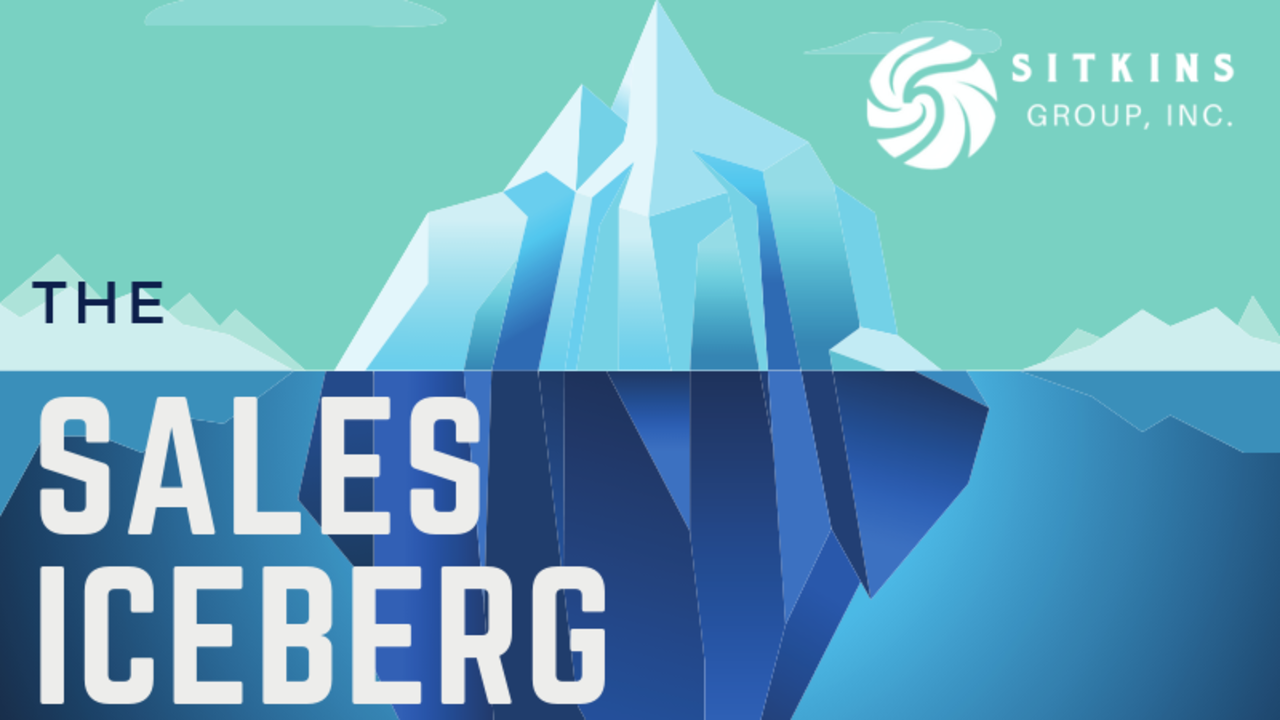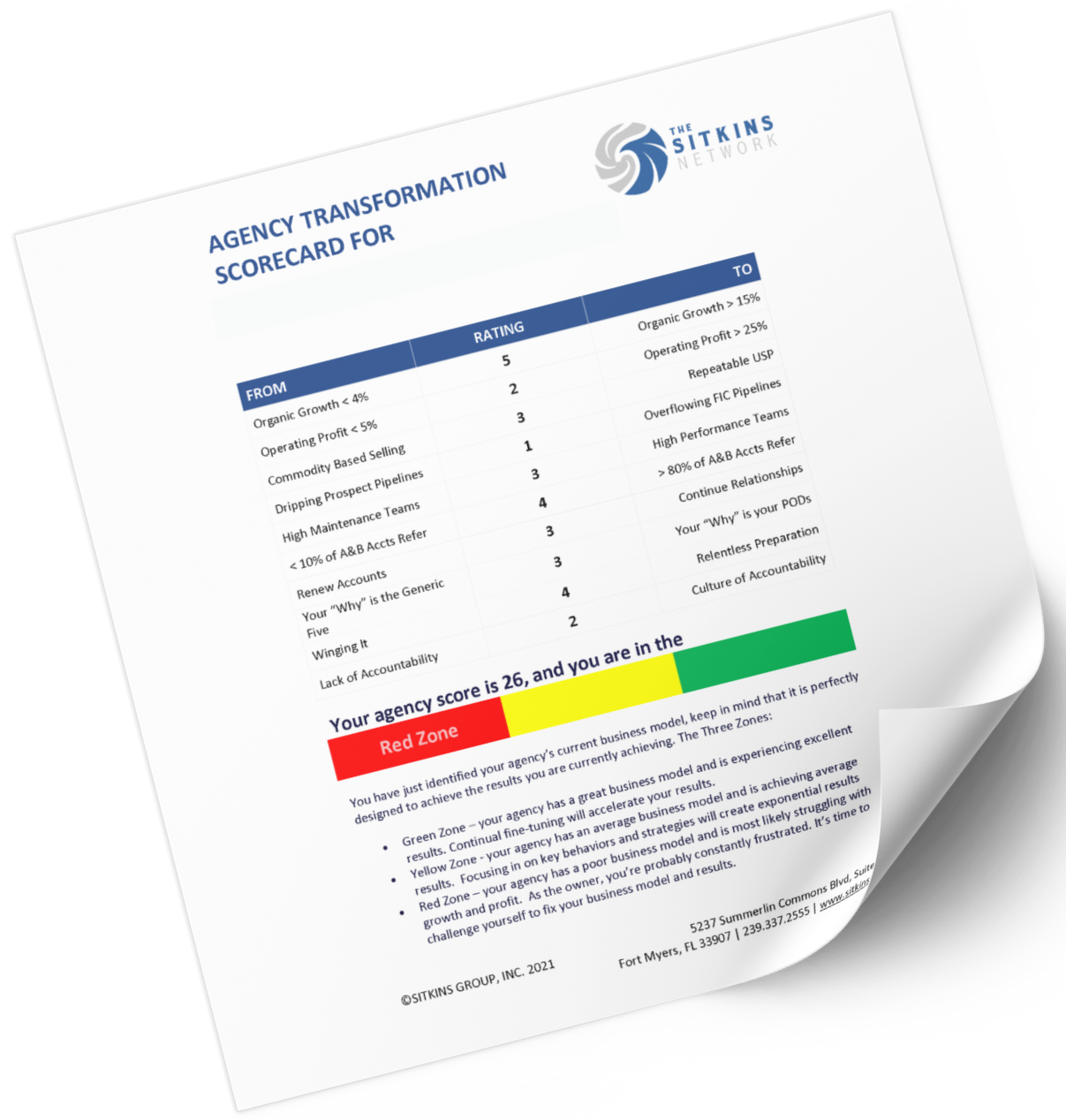The Sales Iceberg

LOOK BELOW THE SURFACE TO SEE WHAT DRIVES YOUR SALES SUCCESS
We all know the tragic tale of the RMS Titanic, which sank in 1912 after it struck an iceberg south of the Grand Banks of Newfoundland. Of course, it was the mass beneath the surface that caused the lethal damage. That’s no surprise considering that only 10% of an iceberg’s mass is above the waterline, whereas 90% is below it.
In many ways, insurance/risk management is like an iceberg. Most people are familiar with only what’s above the waterline, which are product and price. Below the waterline are all the value-added services and risk factors that not only determine the product and price but also differentiate agencies and their producers from competitors.
Similarly, I see an analogy between icebergs and success in sales. The sale itself is what people notice because it’s above the waterline. It’s visible, which is why it’s so exciting! Conversely, few people consider the behaviors and strategies that lead to a successful sale because they are below the waterline. If only they would look beneath the surface, they would see why they did or didn’t make the sale. Success leaves clues, and so does failure.
What lies beneath
After analyzing the best strategies and behaviors of the best producers, we have identified some of the key drivers of “above-the-waterline” success. Typically, most salespeople either ignore or downplay them, because they’re focused solely on product and price. To dramatically improve their new organic growth, they should be shifting their attention to what’s below the waterline.
Concentrating on what’s below the surface all starts with pipelines (I know—something you’ve never heard from me before!). I’m not referring to a bunch of random suspects or prospects. Although I’ve sung their praises in the past, prospect funnels are passé. It’s no longer about throwing a bunch of suspects and prospects into a funnel to see what falls out of the bottom. It’s now about flipping the funnel and moving from B2B marketing to Account Based Marketing (ABM) to focus exclusively on Future Ideal Clients (FIC). Although this might mean fewer prospects, you’ll be pursuing the vital few versus the trivial many.
Sadly, it’s rare to see a producer with more than 20 real opportunities (prospects). If you doubt that number, go ask your producers what they have in their pipelines right now that they’re actively working on. What you’re likely to find is a mix of suspects and prospects, and few FICs. It’s also possible that a producer could have a pipeline of 200 prospects or suspects who are nothing more than mirror foggers willing to accept a quote.
What we want in a pipeline are 20 FICs in an ABM program. This should be driven by up-front research to identify your FICs and a marketing strategy tailored specifically to them and their potential insurance-related problems.
Now let’s dive deeper to see what else we need to work on below the waterline, starting with attitude. You must truly believe that every opportunity deserves your very best, period. But what does that really mean? According to the ABM approach, you know the key decision maker(s) for every FIC. Perhaps you’ve gone out of your way to meet them at an industry or community event. Or if you haven’t already met them, you know someone who knows them and can introduce or refer you to them. Furthermore, you’ve done your research up front, so you understand their business. You know that you have the right product/program for them and you know you’ll be competitive—not necessarily the lowest price, but in line with the competition. Also, you understand their class of business and have identified the main concerns or underwriting problems with that particular class by talking with your underwriters and doing even more research.
As an example, I Googled “insurance underwriting problems on restaurants” and got 87 million hits! Granted, I didn’t find much once I got past the first page or two, but those first couple of pages provided several tools I could use if I were a producer preparing to work on a nice restaurant account.
Once you know about specific businesses and their associated underwriting problems, that information can help you develop an opening line to use when you first meet your FIC. You can also use that information to formulate the first three risk-based questions you’ll ask during your initial appointment. By doing the research up front, you’ll look like an expert by the time you get to sit down with them.
Beyond pipelines and ABM
Filling your pipeline and establishing an ABM plan is a good start. But there’s plenty more for you to do below the waterline.
Collect Success Stories. Are you prepared to share how you’ve helped other businesses or individuals? If not, you need to start compiling success stories. By success stories, I’m not talking about testimonial statements, but rather case studies that illustrate how your expertise has improved someone’s business or life.
Pre-Brief and De-Brief. Are you—as an individual or agency overall—pre-briefing and de-briefing every A and B sales opportunity? Several of our clients use a simple whiteboard to pre-brief each opportunity in depth. By doing so, they familiarize themselves with everything they need to know to win the account. Typical talking points include: What is the opportunity? What are our points of differentiation? What other businesses in that class do we currently insure? What do we have to know to get their business? Thanks to their relentless preparation via whiteboarding, their closing ratios keep rising every quarter.
Afterwards, they de-brief every sales opportunity, regardless of the outcome. The key here is to learn from your losses and replicate your victories. Identifying what and why some opportunities go right while others go wrong is far preferable to sitting around during sales meetings and complaining about your carriers and service issues.
Practice, Practice, Practice. One of the most effective ways to succeed as a salesperson in almost any industry comes down to repeatedly doing things to improve your selling skills. That’s why practice is so crucial! For starters, you need to practice your phone calls, your networking skills, your initial meetings, and your presentations. It’s also important to practice handling objections. Do you have a list of the most common objections you encounter and the best ways to respond to them? You should also practice asking for referrals and introductions.
Above all, practice the critical skill of asking questions and actively listening. Too often people ask a question and continue talking rather than waiting for a response. That’s a great way to kill a sale! Every study I’ve ever read about the art of sales indicates that the best salespeople ask thoughtful, open-ended questions 20% of the time and actively listen 80% of the time. (By the way, these are the risk-based questions that will cause pain issues.) If listening is not one of your strong suits, I urge you to practice until it becomes one. Also, write down the word WAIT, an acronym for Why Am I Talking? Chances are you should be listening instead.
Have a High-Performance Team (HPT). It’s vital that you assemble a HPT that allows all producers to invest (not spend) 80% of their time in sales and sales-related activities. I sure hope you remember The 12% Factor that I’ve referenced several times. What gets measured can be improved and recently, I discovered a new Key Performance Indicator (KPI) that I believe agencies should be measuring: Time Spent Selling or TSS.
The reality is that most producers spend about 6% of their time selling (approximately 10 hours per 168-hour week). What happens when your producers increase their TSS from 6% to 12%? A significant improvement in producer productivity (a.k.a., sales)! So if you’re not measuring the amount of time spent selling, how will you know if you’re improving?
As I’ve noted many times before, 90% of what producers do out of the office is better than 90% of what they do in the office. So get out of the office! Believe me, your service team will appreciate it.
Spend Time Preparing. How much time have you spent preparing your story? What’s your 30-second commercial? We’ve always preached that the following three words should form the foundation of your commercial: model, design, and focus. For example, “We have a unique model that is designed to (X) and is focused on (Y).” Now we have a new version, 2.0. “Business owners come to me when (fill in the blank).” For instance, “Business owners come to me when they’re frustrated with their current agency,” or “Business owners come to me when they realize they’re not getting the level of service they could/should be getting.” The same applies to individuals. “Individuals come to me when they realize that all their insurance should be bundled,” or “they realize they’ve never had a risk assessment done on all their personal exposures.”
What you don’t want to hear is that people come to you when they want a free quote! Why do business owners or individuals come to you? Make that a topic at your next sales meeting. Pose the question to producers, along with the follow-up: “And when are we successful with them?” The answer shouldn’t be only about price.
The bottom line
Selling insurance is not a get-rich-quick scheme. It takes time to reach the pinnacle of success. It takes time to simplify your message or story. For example, in a recent article I asked: “What are your top five Points of Differentiation (PODs)?” What have you done with that? Have you identified them yet? It takes time to clarify what differentiates you from your competitors. It’s not something you can just rattle off the top of your head.
I believe that at the core of every agency are its sales process and client experience. What drives your agency? Do you have a differentiated sales process that creates great results? Do you provide an extraordinary experience that keeps clients forever and turns them into raving fans? Are these activities documented and continuously taught in your agency?
Below the waterline, the thing that distinguishes Million Dollar Producers (MDPs) is the Big D—Discipline. The most successful producers have the discipline to practice, research, hold themselves accountable, follow the perfect schedule, maximize selling time, manage relationships, and so much more. Are you cultivating MDPs in your agency?
So often we talk about practicing the right behaviors. That’s because we know the numbers are merely the end result of the right behaviors and strategies. Well, here’s a BFO: Anyone who has the Big D can replicate the right behaviors. Therefore, if you want to see the sunlight of the big sales above the waterline, you’ve got to be willing to do the work below the waterline!
The author
Roger Sitkins, CEO of Sitkins Group, Inc., is the nation’s number-one “Agency Results Coach.” He established The Sitkins Network™, a territorial exclusive network of high-performing agencies, and The Better Way Agency, a web-based training program that shows agency owners ways to make significant improvements in all areas of the agency. To learn more, please visit www.sitkins.com and follow us on Facebook, LinkedIn and Twitter.
You can also sign up for our Podcasts and Blogs so you don't miss any updates on how to sell more, retain more, and earn more.
Stay connected with news and updates!
Join our mailing list to receive the latest news and updates from our team.
Don't worry, your information will not be shared.




